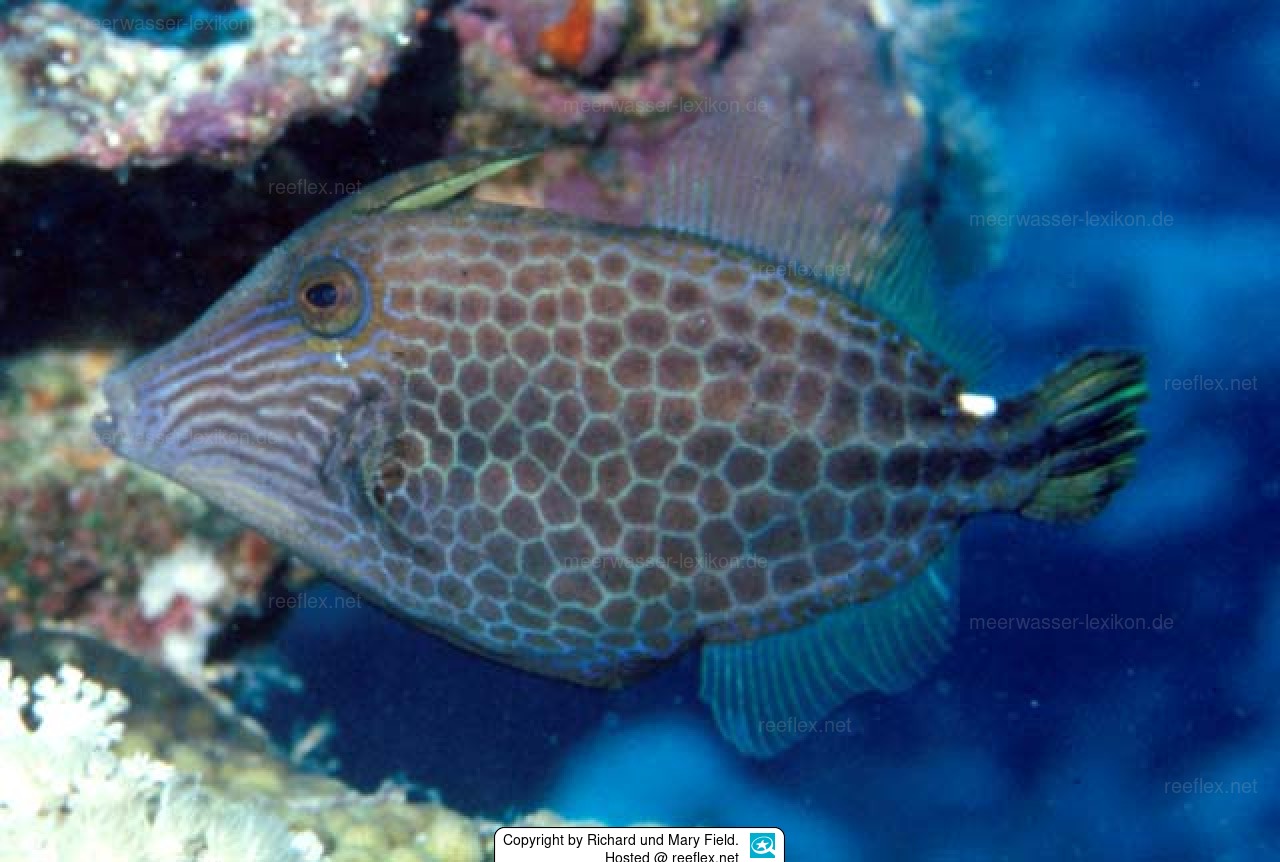Info
Cantherhines pardalis (Rüppell, 1837)
Mottled grey and brown, dark brown, or grey with a network of close-set polygonal spots. All have a small white spot at the rear base of the second dorsal fin and sometimes the anal fin. Solitary. Feeds on benthic organisms:
Synonymised names
Amanses microlepidotus Gray, 1859 · unaccepted
Amanses pardalis (Rüppell, 1837) · unaccepted > superseded combination
Cantherhines melanoides (Ogilby, 1908) · unaccepted
Cantherhines parkalis (Rüppell, 1837) · unaccepted > misspelling - incorrect subsequent spelling
Cantherines pardalis (Rüppell, 1837) · unaccepted (misspelling)
Hanomanctus bovinus Smith, 1949 · unaccepted
Moancanthus kibikib Montrouzier, 1857 · unaccepted (misspelling of a synonym)
Monacanthus aspersus Hollard, 1854 · unaccepted
Monacanthus brunneus Castelnau, 1873 · unaccepted
Monacanthus fatensis Seale, 1906 · unaccepted
Monacanthus fuliginosus MacLeay, 1883 · unaccepted
Monacanthus houttuyni Bleeker, 1854 · unaccepted
Monacanthus kibikib Montrouzier, 1857 · unaccepted
Monacanthus laevicaudatus Duncker & Mohr, 1929 · unaccepted
Monacanthus melanistius Regan, 1908 · unaccepted
Monacanthus melanuropterus Bleeker, 1853 · unaccepted
Monacanthus natalensis Gilchrist & Thompson, 1911 · unaccepted
Monacanthus pardalis Rüppell, 1837 · unaccepted
Pseudomonacanthus melanoides Ogilby, 1908 · unaccepted (synonym)
Mottled grey and brown, dark brown, or grey with a network of close-set polygonal spots. All have a small white spot at the rear base of the second dorsal fin and sometimes the anal fin. Solitary. Feeds on benthic organisms:
Synonymised names
Amanses microlepidotus Gray, 1859 · unaccepted
Amanses pardalis (Rüppell, 1837) · unaccepted > superseded combination
Cantherhines melanoides (Ogilby, 1908) · unaccepted
Cantherhines parkalis (Rüppell, 1837) · unaccepted > misspelling - incorrect subsequent spelling
Cantherines pardalis (Rüppell, 1837) · unaccepted (misspelling)
Hanomanctus bovinus Smith, 1949 · unaccepted
Moancanthus kibikib Montrouzier, 1857 · unaccepted (misspelling of a synonym)
Monacanthus aspersus Hollard, 1854 · unaccepted
Monacanthus brunneus Castelnau, 1873 · unaccepted
Monacanthus fatensis Seale, 1906 · unaccepted
Monacanthus fuliginosus MacLeay, 1883 · unaccepted
Monacanthus houttuyni Bleeker, 1854 · unaccepted
Monacanthus kibikib Montrouzier, 1857 · unaccepted
Monacanthus laevicaudatus Duncker & Mohr, 1929 · unaccepted
Monacanthus melanistius Regan, 1908 · unaccepted
Monacanthus melanuropterus Bleeker, 1853 · unaccepted
Monacanthus natalensis Gilchrist & Thompson, 1911 · unaccepted
Monacanthus pardalis Rüppell, 1837 · unaccepted
Pseudomonacanthus melanoides Ogilby, 1908 · unaccepted (synonym)







 Richard und Mary Field, Malta
Richard und Mary Field, Malta




















